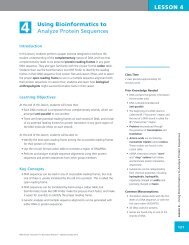WET LAB DNA Barcoding: From Samples to Sequences - Northwest ...
WET LAB DNA Barcoding: From Samples to Sequences - Northwest ...
WET LAB DNA Barcoding: From Samples to Sequences - Northwest ...
Create successful ePaper yourself
Turn your PDF publications into a flip-book with our unique Google optimized e-Paper software.
<strong>WET</strong> <strong>LAB</strong><br />
CLASS SET<br />
9. Add each of the following components <strong>to</strong> your 1.7 ml microfuge tube, in the order listed below. Try <strong>to</strong> keep<br />
the components on ice as much as possible.<br />
a. 40.0 μl of nuclease-free water (labeled “Water”)<br />
b. 5.0 μl of your purified <strong>DNA</strong><br />
c. 5.0 μl of COI primer pool (labeled “COI-2” or “COI-3” depending upon pool)<br />
10. Have one member of your group prepare the PCR mixture for the Negative Control by adding each of the<br />
following ingredients <strong>to</strong> the 1.7 ml Negative Control microfuge tube (“0”) for your group.<br />
a. 45.0 μl of nuclease-free water (“Water”)<br />
b. 5.0 μl of COI primer pool (labeled “COI-2” or “COI-3” depending upon pool)<br />
11. Mix your 1.7 ml microfuge tube containing your PCR mixture by closing the lid and flicking the tube with<br />
your finger.<br />
12. Spin down the contents of your 1.7 ml microfuge tube with your PCR mixture.<br />
13. Repeat the mixing and spinning steps above for your Negative Control tube (“0”).<br />
14. Add all 50 μl of your PCR mixture from your 1.7 ml microfuge tube <strong>to</strong> your labeled 0.2 ml PCR tube.<br />
15. Have one member of your group add all 50 μl of the Negative Control PCR mixture from the Negative Control<br />
“0” 1.7 ml microfuge tube <strong>to</strong> the corresponding Negative Control “0” 0.2 ml PCR tube for your group.<br />
16. Working with your teacher and the rest of your class, put all 5 of your group’s tubes in<strong>to</strong> the thermocycler.<br />
The PCR reaction conditions are as follows:<br />
1 cycle: 94 °C for 2 minutes [initial denaturation]<br />
Thermocycler: Type of machine<br />
35 cycles: 94 °C for 30 seconds [denaturation]<br />
used <strong>to</strong> au<strong>to</strong>mate polymerase<br />
52 °C for 40 seconds [annealing]<br />
chain reaction that cycles<br />
through all of the temperatures<br />
72 °C for 1 minute [elongation]<br />
required <strong>to</strong> complete the PCR.<br />
1 cycle: 72 °C for 10 minutes [final elongation]<br />
Overnight: 4 °C<br />
On your separate sheet of paper or in your lab notebook, answer each of the following questions:<br />
Question 1. What did you do in this labora<strong>to</strong>ry experiment and why?<br />
Question 2. What skills did you learn or practice?<br />
Question 3. What are we testing for in the Negative Control PCR? What do you expect <strong>to</strong> happen in this PCR?<br />
Wet Lab – <strong>DNA</strong> <strong>Barcoding</strong>: <strong>From</strong> <strong>Samples</strong> <strong>to</strong> <strong>Sequences</strong><br />
357<br />
©<strong>Northwest</strong> Association for Biomedical Research—Updated Oc<strong>to</strong>ber 2012
















